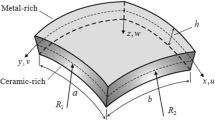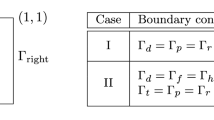Abstract
This paper investigates normal and shear stress distributions of anisotropic three-dimensional (3D) curved bodies using the Refined Finite Difference method (FDM). In the numerical analysis of various mechanical problems involving complex partial differential equations, the FDM has an advantage over the Finite Element Method in its ability to avoid mesh generation and numerical integration. One of the important points in the finite difference formulation for 3D anisotropic problems is the generalized approach for various boundary conditions. Many studies in FDM have been made on clamped or simple boundary conditions using merely an energy approach. These approaches cannot be satisfied, however, with pivotal points along the free boundary. This study addresses the 3D problem of anisotropic curved bodies by adopting a refined 3D finite difference modeling elimination of pivotal difference points in the case of a free boundary condition. Numerical examples present stress distribution characteristics through the depth direction of more complicated anisotropic curved bodies. The study also demonstrates the differences between the displacement and stress characteristics of isotropic, orthotropic and anisotropic cases.
Similar content being viewed by others
References
Al-khafaji, A.W. and Tooley, J.R. (1986).Numerical Methods in Engineering Practice. Holt, Rinehart and Winston, Inc., pp. 342–370.
Bencharif, N. (1988).Application of the Finite Difference Method to the Deflection of Clamped and Simply-supported Thick Rectangular Plates. M.A. Science thesis, Ottawa University, Ontario, Canada.
Chang, S.Y. and Yoo, C.S. (1980). “The Stress Distributions of a Partial Uniform Load Applied to Timber.”Proc. 11th Conf. IABSE Vienna, Austria.
Chang, S.Y. (1984). “Analysis of an Orthotropic Body under a Partial Uniform Shear Load.”KSCE. No. 4.
Chang, S.Y. and Park, W.T. (1992). “Analysis of Anisotropic Symmetric Laminated Curved Plates.”Proc. 2nd Japan-Korea Joint Seminar on Steel Bridges. Tokyo, Japan, pp. 265–276.
Cocchi, G.M. and Cappello, F. (1990). “Convergence in Elastic Static analysis of Three-dimensional Continua Using the Finite Difference Method with Arbitrary Grids.”Computer & Structures, Vol. 36, No. 3, pp. 389–400.
Conway, H.D. (1953). “Some Problems of Orthotropic Plane Stress.”J. Appl. Mech. Trans, ASME, Vol. 75, pp. 72–76.
Lee, S.Y. (1997).A Study on the In-plane Behavior of Anisotropic Laminated Annular Plates. M.A. Science thesis, University of Seoul, Seoul, Korea.
Lee, S.Y. and Chang, S.Y. (2002). “Stress Distributions of Anisotropic Three-dimensional Semi-infinite Bodies by a Refined Finite Difference Formulation.”Journal of Civil Engineering, Vol. 6, No. 4, pp. 447–455.
Lekhnitskiy, S.G. (1950).Theory of Elasticity of an Anisotropic Body. Gostekhizdat, Moscow.
Lusas, “Theory & Applications”, FEA Ltd, United Kingdom.
Muskhelishvili, N.I. (1954).Some Basic Problems of the Mathematical Theory of Elasticity. Fourth, Corrected and Augmented Editions, Moscow.
Ng, S.F. and Bencharif, N. (1989). “A Finite Difference Computer Program for the Modeling of Thick Rectangular Plates.”Computer & Structures, Vol. 33, No. 4, pp. 1011–1016.
Noor, A.K. (1973). “Mixed Finite Difference Scheme for the Analysis of Simply-supported Thick Plates.”Computers and Structures, Vol. 3, pp. 967–982.
Ozaksa, M., Hinton, E. and Rao, N.V.R. (1992). “Comparison of Three-dimensional Solid Elements in the Analysis of Plates.”Computer & Structures, Vol. 42, pp. 953–968.
Pagano, N.J. (1970). “Exact Solutions for Rectangular Bi-directional Composites and Sandwich Plates.”J. Composite Mat., Vol. 4, pp. 20–34.
Paik, H.S. (2002).Three dimensional Analysis of Anisotropic Cylindrical Bodies using Finite Difference. Ph.D. thesis. University of Seoul, Seoul, Korea.
Timoshenko, S.P. and Goodier, J.P. (1970).Theory of Elasticity. McGraw-Hill, Inc., pp. 65–149.
Author information
Authors and Affiliations
Corresponding author
Rights and permissions
About this article
Cite this article
Paik, H.S., Lee, S.Y. & Chang, S.Y. Finite difference stress analysis of anisotropic three-dimensional curved bodies with free boundaries. KSCE J Civ Eng 8, 49–57 (2004). https://doi.org/10.1007/BF02829080
Received:
Accepted:
Issue Date:
DOI: https://doi.org/10.1007/BF02829080




